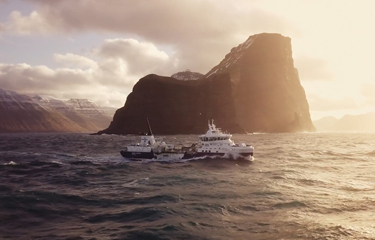Amid a strong salmon market and record high prices, Bakkafrost Group delivered total operating earnings before interest and taxes (EBIT) of DKK 417.9 million (USD 59.2 million, EUR 56.2 million) in the first-quarter of this year, up from the DKK 223.5 million (USD 31.7 million, EUR 30 million) it posted for the corresponding period of 2021.
The Faroe Islands-headquartered Atlantic salmon producer’s profit for the three-month period was DKK 404.8 (USD 57.4 million, EUR 54.4 million), down slightly on Q1 2021’s DKK 407.7 million (USD 57.9 million, EUR 54.8 million) in Q1 2020, while its revenues increased by more than DKK 463 million (USD 65.6 million, EUR 62.2 million) to over DKK 1.6 billion (USD 226.8 million, EUR 215.1 million).
Bakkafrost CEO Regin Jacobsen said that overall, the group was pleased with the results from its Faroese farming operation and its fishmeal, oil, and feed (FOF) segment.
“In this quarter, our farming operation in the Faroe Islands has continued on the trajectory to higher volumes. The biology has been good and sea lice levels low. The expansions of the Norðtoftir and Glyvradal hatcheries are also progressing as planned and will be completed later this year,” he said.
Jacobsen explained that despite “disappointing results” in its Scottish farming operation, Bakkafrost was pleased to see “clear improvements” during the quarter, following the challenging biology and high mortality seen through Q3 and Q4 2021.
At the beginning of Q1 2022, the biology was still negatively affected at a few sites by the gill health issues in the two previous quarters, which caused elevated mortality at these sites, he said.
“The issues reduced during Q1 2022 and in March we had no exceptional mortality, and the Scottish farming operation was profitable again,” Jacobsen explained.
In the quarter, Bakkafrost also more than doubled its freshwater-treatment capacity in Scotland with the introduction of a second large freshwater-treatment vessel. The group is confident the move will significantly improve its ability to reduce biological risks. Jacobsen also said Scotland’s Applecross 4 expansion is expected to be finalized in Q4, which will enable it to be self-sufficient “with high-quality smolt of significantly larger size than today.”
This will be the first major milestone in transforming the Scottish farming operation, he said.
Bakkafrost’s salmon harvest in Q1 amounted to 21,432 metric tons (MT) gutted weight, up slightly from 21,027 MT a year previously. Of this, some 17,459 was from the Faroes – up from 14,025 MT in Q1 2021 – but just 3,973 MT from Scotland (7,022 MT in Q1 2021).
Bakkafrost’s farming segment in the Faroe Islands achieved an operational EBIT of DKK 471.4 million (USD 66.8 million, EUR 63.4 million) in the quarter, up from DKK 143.3 million (USD 20.3 million, EUR 19.3 million). The segment’s operational earnings before interest, taxes, depreciation and amortization (EBITDA) of DKK 86.4 million (USD 12.3 million, EUR 11.6 million), represented an increase of DKK 38.1 million (USD 5.4 million, EUR 5.1 million) on the corresponding period of last year.
However, its farming segment in Scotland suffered a loss of DKK 52.6 million (USD 7.5 million, EUR 7.1 million), a worsening of its Q1 2021 loss of DKK 7.3 million (USD 1 million, EUR 981,000) in Q1 2021. Its value-added products segment also posted a loss of DKK 29.4 million (USD 4.2 million, EUR 4 million), down from DKK 75 million (USD 10.6 million, EUR 10.1 million) in Q1 2021.
Bakkafrost’s harvest volumes for 2021 from the Faroe Islands are expected to be 68,000 MT gutted weight and 35,000 MT gutted-weight in Scotland, resulting in a total harvest of 103,000 MT. It also anticipates releasing 14.9 million large smolts in the Faroe Islands, and 10.8 million smolts of around 120 grams in Scotland.
“The salmon market has been exceptionally strong so far in 2022 with record high salmon prices. We do not expect prices to remain as high as they have been lately but expect prices to come down somewhat for the rest of 2022, however still on a strong level due to a tight supply outlook,” Jacobsen said.
Through its investments in the Faroe Islands – including increasing its annual hatchery production capacity to above 23 million smolt at 500 grams, investments in a broodstock facility, and expansion of feed production capacity. Bakkafrost expects to grow its total annual harvest volumes to 150,000 MT in 2026. Over the same period, it anticipates that the total annual production capacity in its value chain will reach 180,000 MT gutted-weight.
Its aquafeed sales, completed through its Havsbrún operations, are expected to top out at 130,000 MT in 2022. The main recipient of Havsbrún's fish feed is the local Faroese market, including Bakkafrost’s internal use of fish feed. This feed is also used in its Scottish farming operations. Jacobsen said vertical integration will continue to play a key role in the company’s success, especially in the current unsettled state of the seafood market.
“The disruption in global supply chains has strengthened the need for local sourcing. In this respect, Bakkafrost is in a good position as around two-thirds of our sourcing is from local suppliers, and we have good access to locally-caught marine raw material for our feed production,” Jacobsen said.
Photo courtesy of Bakkafrost







